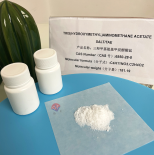Chinese VersionChina Suppliers > Hubei new DE sheng material science and technology co., LTD. > Component Analysis of Biological Buffer TAE
- Search Product
-
-
- Region :China/Hubei
- Tel : +86-18971041571
- Fax :
- Email :vickyzhao@whdschem.com
- URL :
- Add :Guanggu United Science and Technology City C8, Ezhou City, Hubei Province
- Details for Component Analysis of Biological Buffer TAE
-
Component Analysis of Biological Buffer TAE
Category : Other Chemicals/Others

CAS NO : 6850-28-8 EC NO : 229-939-6 MF : C14H17N3O4 MW : 291.30248 Specification : White Powder Packing : 500g/bottle Product description : In life science experiments, biological buffering agents are widely used to maintain the acid-base balance inside and outside cells, ensuring normal physiological functions of cells. Among them, TAE (Tris Acetate EDTA) buffer is highly favored due to its stable performance and wide applicability. This article will provide in-depth analysis of the components of the biological buffer TAE, in order to provide theoretical support for related research. Composition 1. Tris base: Tris (hydroxide) amine is an organic base with sufficient buffering capacity, which can effectively neutralize acidic substances and maintain pH stability of the solution. 2. Acetic acid: Acetic acid is an acidic component in TAE buffer, which works together with Tris base to regulate the pH value of the solution. In biological experiments, acetic acid can also provide acetyl groups required for cellular metabolism and participate in biochemical reactions within cells. 3. EDTA: EDTA (ethylenediaminetetraacetic acid) is a metal chelating agent that can combine with various metal ions to form stable chelates, thereby suppressing the interference of metal ions in experiments. In TAE buffer, EDTA is mainly used for chelating metal ions such as calcium and magnesium to avoid unnecessary effects during the experimental process. Performance characteristics 1. Stability: TAE buffer exhibits good stability at room temperature and can maintain pH stability for a long time. This makes TAE buffer an ideal choice for long-term or large-scale experiments. 2. Wide applicability: TAE buffer is suitable for various biological samples and experimental conditions. Due to its relatively mild composition and non toxicity to cells, it has been widely used in experiments such as cell culture, PCR reaction, and electrophoresis. 3. Adjustability: According to experimental requirements, the pH value and ion strength of TAE buffer can be adjusted by adjusting the concentrations of Tris base, acetic acid, and EDTA to meet the requirements of different experimental conditions. Uses : Biological buffer Synonyms : trizma acetate;Tris acetate;1,3-dihydroxy-2-(hydroxymethyl)propan-2-aminium acetate;TRIS-ACETATE;Tris(hydroxymethyl)amino methane acetate;Tris acetate salt;TAE; Molecular Structure : 
- more>>Other Products
-
- • Biological buffer 3- [N, N-di (hydroxyethyl) amino] -2-hydroxypropanesulfonic acid DIPSO
- • Luminol Sodium Salt
- • 4-Aminophthalhydrazide
- • acridinium ester DMAE-NHS
- • acridinium ester NSP-DMAE-NHS
- • Acridine hydrochloride NSP-SA
- • Acridine hydrochloride NSP-SA-NHS
- • NSP-SA-ADH
- • acridinium ester ME-DMAE-NHS TOOS; 3-(N-Ethyl-3-Methylanilino)-2-Hydroxypropanesulfonic Acid Sodium Salt
- • TOPS; Sodium 3-(N-Ethyl-3-Methylanilino)Propanesulfonate; N-Ethyl-N-Sulfopropyl-M-Toluidine Sodium Salt
- • ADOS Sodium 3-(Ethyl(3-Methoxyphenyl)Amino)-2-Hydroxypropane-1-Sulfonate Dihydrate
- • ADPS N-Ethyl-N-(3-Sulfopropyl)-3-Methoxyaniline Sodium Salt
- • ALPS N-Ethyl-N-(3-Sulfopropyl)Aniline Sodium Salt; Sodium 3-(Ethyl(Phenyl)Amino)Propane-1-Sulfonate; Sodium
- • DAOS; Sodium 3-((3,5-Dimethoxyphenyl)(Ethyl)Amino)-2-Hydroxypropane-1-Sulfonate
- • HDAOS; N-(2-Hydroxy-3-Sulfopropyl)-3,5-Dimethoxyaniline Sodium Salt
- • MADB N,N-Bis(4-Sulfobutyl)-3,5-Dimethylaniline Disodium Salt
- • MAOS N-Ethyl-N-(2-Hydroxy-3-Sulfopropyl)-3,5-Dimethylaniline Sodium Salt Monohydrate
- • DAB 3,3',4,4'-Biphenyltetramine Tetrahydrochloride